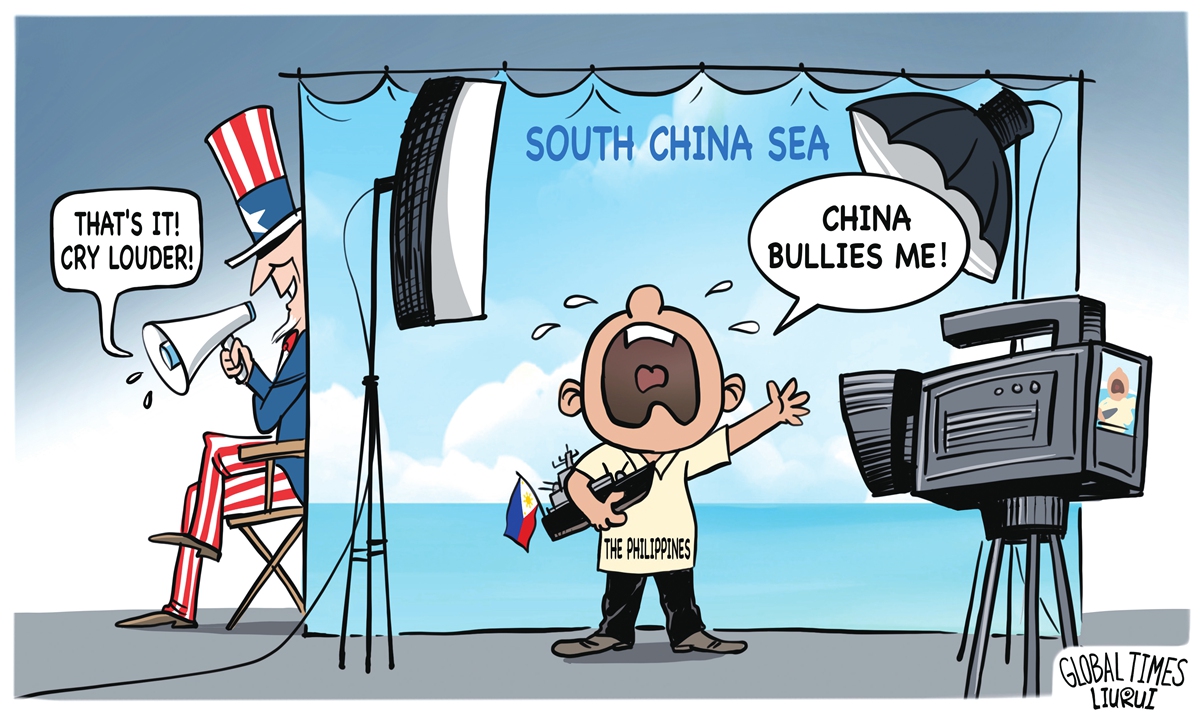What’s behind the Philippines’ sadfishing in the South China Sea

Behind the scenes. Illustration: Liu Rui/GT
In the South China Sea, one of the world’s most important waterways with 60 percent of global trade passing through every day, Filipino boats loaded with construction materials and journalists frequently encroach into the waters of China’s Ren’ai Jiao in the past months, disrupting calm and stability in the region.
Almost after each intrusion, videos and stories can be seen on the internet that show China Coast Guard vessels alone taking action, making the Philippines look like the “victim” as part of those encounters. Contrary to what meets the eye, such sensationalization is yet another episode of the Philippines acting as “a-thief-crying-stop-thief” trick to stir up geopolitical trouble in the South China Sea.
Resupply or reinforcement?
The origin of the recent clashes between the Philippines and China dates back to 25 years ago when the Filipino military vessel BRP Sierra Madre, a dilapidated US battleship, claimed that they ran aground in China’s Ren’ai Jiao and has remained there since, which is illegal. Though the Philippines has repeatedly promised to tow the vessel away, the promise has never been fulfilled and the navy hulk is still illegally sitting at the shoal.
Since that time, the Philippines has sent soldiers there with an agenda of turning the crumbling vessel into a permanent outpost as a “symbol” of Philippine “sovereignty” at sea. The latest Philippine resupply mission, under the excuse of sending essential supplies, was to bring construction materials for vessel repair and reinforcement. Its real aim is to illegally encroach on the uninhabited Ren’ai Jiao which is Chinese territory.
Who is the ‘veiled expert’?
On March 23, several Philippine vessels carrying journalists ready to produce “compelling narratives” of run-ins with the Chinese vessels once again intruded into the waters around the Ren’ai Jiao. Tasked with portraying Chinese vessels as the bully, reporters on board took photos and videos which were revealed by China’s MOFA spokesperson to have been “manipulated to make sensational news and paint the Philippines as a victim.”
These videos were re-tweeted by Ray Powell who served in the US Air Force and currently leads Project Myoushu, a Stanford-based project that shapes the situation in the region in favor of US interests via an array of provocative activities to add fuel to the flames and sow discord. Many signs suggest that the recent standoff was deliberately orchestrated to stoke maritime confrontation and increase antagonism between China and the Philippines.
Who will lose the game?
Myoushu, originally a term in the game of go, means an “inspired move” that turns a game on its head. But the ill-intentioned maneuvering, gaslighting and smearing of China will never succeed. Given the US intention to expand influence in the Pacific in its presumed contest to shape the regional order, the balance of power and even international norms and rules, the Philippines is actually “inviting wolves into the house” by courting external forces.
The South China Sea should by no means become a chessboard for a geopolitical game. The US and the Philippines have threatened to resort to their Mutual Defense Treaty. “Shoulder-to-shoulder” joint military exercise was staged to flex their muscles on China’s doorstep. Needless to say, the increasing US intervention is the major risk driving up tensions at sea. If the Philippines does not change course, it may run the risk of becoming entangled in an escalatory spiral of friction and conflicts.
The South China Sea should be a peaceful, secure, prosperous, beautiful and amicable home for people living in this region. No one should trade the tranquility of the Sea and people’s livelihood for elusive external support or selfish gains. Scheming and colluding with external forces would only muddy the waters. Concerted efforts of regional countries to settle differences peacefully and pursue cooperation are the only way to navigate the stormy seas.
The author is a commentator on international affairs, writing regularly for Xinhua News, Global Times, China Daily, CGTN, etc. He can be reached at [email protected].












